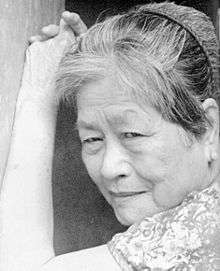Rosa Henson
| Maria Rosa Luna Henson | |
|---|---|
 Henson in March 1996 | |
| Born | December 5, 1927 |
| Died | August 18, 1997 (aged 69) |
| Other names | "Lola Rosa" |
María Rosa Luna Henson or "Lola Rosa" ("Grandma Rosa") (1927–1997) was the first Filipina who made public her story as a comfort woman (military sex slave) for the Imperial Japanese Army during the Second World War.
Her story
Maria Rosa Luna Henson was born on December 5, 1927. She grew up in poverty in Pampanga with her single mother, Julia. Born the illegitimate child of Don Pepe, a wealthy landowner, Henson saw her father sporadically throughout her childhood. After World War II started, Henson became a member of the Hukbalahap, a Filipino people’s army resisting Japanese invaders. In April 1943 while with her comrades, Henson was taken by Japanese soldiers and led the local Japanese headquarters where she was forced to be a “comfort woman.” In August 1943, Henson and the other girls were transferred to a larger building where the routine continued. In January 1944, Hukbalahap guerrillas attacked the building and freed Henson. After nine months of being a comfort woman, Henson greatly suffered psychologically and physically. She eventually married a young soldier named Domingo and had three children: Rosario (August 1947), Rosalinda (September 1949), and Jesus (December 1951). Domingo was killed in November 1953. Starting in 1957, Henson worked in a cigarette factory for thirty-four years.[1]
In 1992, when Henson was 65, she decided it was time to tell the world about her experience during the Japanese occupation of the Philippines during the war. Until 1992, only two people had known of her secret: her late mother and her dead husband. After coming out publicly with her story at a press conference in September 1992, Lola Rosa decided to write about her war-time experience in the book, Comfort Woman: A Slave of Destiny.
In Comfort Woman: A Slave of Destiny, Lola Rosa provided a straightforward voice to the erstwhile silent and invisible existence of Filipino comfort women. Fifty Filipino women soon followed Rosa’s example as they decided to reveal themselves and their personal stories for the first time—not only to the world, but to their families as well. Other victims, including those from Korea and China, joined the Filipino women to file a class action lawsuit against the Japanese government in December 1993. Together, they demanded justice in the form of a formal apology from the Japanese government; the inclusion of all the war-time atrocities committed by the Japanese into Japan’s school history books; and monetary reparations to compensate for all the abuses and violence committed against the women.
However, the Japanese government denied legal responsibility and refused to pay the victims. Later, responding to the growing pressure of continued protests and appeals by the survivors and their supporters, Japan finally set up the Asian Women’s Fund (AWF) in 1995 to collect money from private Japanese citizens, and offered them to the victims as “atonement payments.” Henson died of a heart attack in August 1997, a year after she decided to accept monetary reparations from the AWF.[2]
See also
- Timeline of Philippine history
- Walterina Markova, a man who served as a "comfort gay" during the war
References
- ↑ Comfort woman A Filipina's story of prostitution and slavery under the Japanese military Book / Henson, Maria Rosa 1927. Lanham, Md.: Rowman & Littlefield, 1999. English
- ↑ http://www.nytimes.com/1997/08/27/world/maria-rosa-henson-69-dies-victim-of-japanese-brothels.html. Seth Mydans. Retrieved November 1, 2015
- Comfort Woman: Slave of Destiny, Maria Rosa Luna Henson: Woman of Courage, KASAMA Vol. 11 No. 3, Solidarity Philippines Australia Network, Cpcabrisbane.org, July–August–September 1997 and Philippine Center for Investigative Journalism, Manila, retrieved on: 10 June 2007
- Maria Rosa Luna Henson (1927 - 1997), Ateneo Library of Women's Writings (ALIWW), Ateneo de Manila University, Philippines and Rizal.Lib.Admu.edu.ph, retrieved on: 10 June 2007
- Comfort Women Slam Japan Apology, Newsbits Vol. 9.8, Reuter and MIT.edu, retrieved on: 10 June 2007
- Maria Rosa Henson 69 Dies Victim of Japanese Brothels, retrieved on: 1 November 2015
- Testimonies of the Victims, Retrieved 1 November 2015.
External links
| Wikimedia Commons has media related to Rosa Henson. |